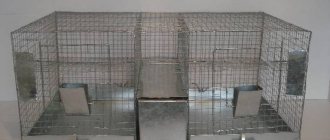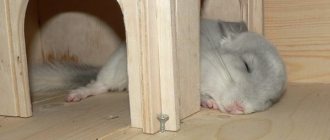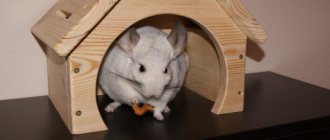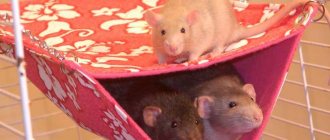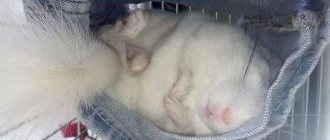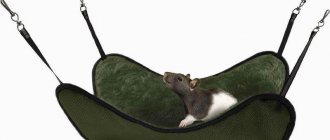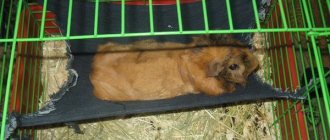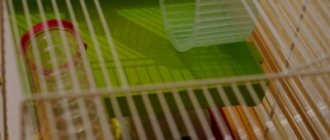Requirements for a rookery
The hammock should be such that it can be easily installed where the cat likes to bask. There should be no clothing or other items near this place from which it is difficult to remove hair. Rodent models are usually placed in cages.
It is worth paying attention to the strength of the frame. Not every foundation will support a Maine Coon or just a heavy cat. A lightweight frame is also suitable for a chinchilla or rat. When attaching it to the battery, you need to take into account that under heavy weight it can come off along with the cat and the hammock. For a heavy animal, the bed is made on the basis of a durable but light frame, for example, aluminum.
It is important how the product will be attached to the battery or other object. It is fixed to an old-style sectional radiator using bent hooks. If the heating element consists of plates, it is better to use special rectangular fasteners for installation. A do-it-yourself hammock for a cat is attached to the battery on the top or side. How exactly depends on the preferences of the pet.
There are cats that like to snuggle almost closely to a warm surface. A lounger hanging on the side and adjacent to a heated radiator is suitable for this type. For purrs who prefer to sit a little away from the heat source, make a hammock raised above the surface by 15-20 cm.
The next point that cannot be ignored is the fabric that serves as the cover. Cats do not like synthetic fabrics, no matter how slippery or fluffy they are. Suitable material with the following characteristics:
- dense;
- lasting;
- abrasion resistant;
- elastic;
- Machine washable.
All these factors must be taken into account both when purchasing and when making a hammock. It is worth thinking about where the product will be located in advance. If there are several heaters in the apartment, you should observe which one the animal prefers.
Operating rules
Now you know how to make a hammock for a nimble animal, but you need to know how to use it correctly. Failure to follow safety precautions may result in injury to your hamster.
So, here are the recommendations for using a hanging bed:
- It is better to place the hamster hammock on the second tier of the cage.
- It should not be hung too high above the surface of the second floor, so that the animal does not suddenly hurt itself.
- At first, watch the animal to see if it is gnawing on a new piece of furniture. If the home does not try to test the furniture, then you can leave the hammock overnight.
- Fluffy can bring food into the bed and litter. He is also capable of “playing whale” right in the hammock. Therefore, you will have to wash it periodically with soap.
Our tips will help ensure your hamster's safety and comfort.
Thus, making a comfortable hanging bed for your pet is not difficult at all. The main thing is to have the desire and a little free time. You can also get creative and attach ladders to the hammock or decorate it in some way.
Source
Advantages and disadvantages
The hammock is simple and easy to use, but the main thing is that you don’t need to accustom your cat to it. She will immediately understand that lying in a warm nest that takes the shape of her body is more comfortable than lying on a hard, flat surface. The undeniable advantage of the compact model is the ability to free up space that was previously occupied by a bed made from scrap materials.
A hammock will come in handy at any time of the year. In winter, the cat will bask in it, and in summer, it will escape the heat next to the cold metal. Owners will be relieved of the need to frequently clean furniture and clothing from adhering wool. If the hammock is temporarily not needed, it can be easily removed and stored .
Such products also have disadvantages, and it is better to think about them in advance. So, staying near a heating device for a long time leads to the animal overheating. Jumping out into the yard or onto the balcony to cool off, the cat may get sick. The second serious disadvantage is the drying out of the wool. Because of this, pets sometimes begin to shed prematurely, and this is not the only possible problem.
To play it safe, you should consult a veterinarian. If the cat has recently been operated on or suffers from a chronic disease, it is better to place the rookery at a decent distance from the heating structure.
What can you make a hanging bed from?
When deciding to build a hanging bed for your rodent, it is important to reconsider the advantages and disadvantages of all possible design options for such a device. The first thing that is important is reliability. Therefore, the materials must be durable and of high quality. The simplest options for a hanging bed will be:
- Accessory made of fabric. It will require a couple of small squares of the fabric itself, a synthetic padding lining, metal carabiners, braid and sewing supplies (needle and thread, scissors, etc.).
- A device made from a washcloth. The simplest and most economical option. To make it, you only need a washcloth and thick wire.
- Accessory made of yarn. Suitable for those who know how to knit and crochet.
It is not advisable to consider a bed made of yarn. This option is short-lived and is more suitable for calm rodents. The yarn is quickly frayed or chewed by the animal itself.
Popular models
The first thing you can use to make a hammock for your indoor cat is an unnecessary dish drainer. It is suitable for animals of medium and small breeds. This product has a strong base and a suitable shape. The structure is hung on the radiator sections, secured with twine. To ensure that the rods located on the underside do not interfere with the hammock’s bending, they are removed with wire cutters.
Sewing a cover begins by measuring the length and width of the walls and bottom of the dryer , then multiplying the resulting number by 2. Cut out the fabric from the fabric, not forgetting to leave seam allowances. Three sides are sewn together, but the fourth is not touched yet. A piece is cut out of padding polyester of such a size that it fits inside when folded. How many layers there will be depends on the thickness of the insulation. Then it is folded to the desired state, stitched in different directions and placed inside the cover.
A zipper is carefully sewn into the fourth side of the fabric. Strings or loops with buttons are sewn into the corners. They are needed so that the case does not wrinkle or bunch up. Now you can put the product on the dryer, secure everything to the radiator and put the cat there.
The hammock, which will be mounted not on the side, but on top of the heating device, is made from boards. It will be appreciated by pets who prefer moderate heat. You need to take 4 strong wide boards and put together 2 stands in the shape of the letter G from them. Spacers are placed on both stands near the junction of the boards.
How to make a hammock for a hamster with your own hands
A homemade hammock for a hamster is made depending on the breed and size of the pet. It is necessary that the hanging bed be spacious - about 2-3 times larger than a rodent.
A fabric hammock, usually three- or four-cornered, is considered classic. Skilled needlewomen can make it from yarn or other suitable material. A simple fiber washcloth can also act as an unusual bedding option.
From yarn
For a knitted cradle, you need to select soft yarn that contains viscose and acrylic. You can knit using knitting needles or crochet. The main requirement is high density of the product.
To tie a corner hammock, you need to prepare:
- yarn;
- hook No. 1.5–2 for thin yarn or No. 4–5 for thick yarn;
- scissors.
An isosceles triangle with sides of 15 cm is knitted. The length of the hypotenuse depends on the distance between the rods of the cage where the hammock will hang. The work begins with knitting a chain of air loops - this is the future base of the triangle. All subsequent rows consist of single crochets.
In each row after the first, the number of columns should be reduced down to 2-3 pieces at the last level. This produces the required triangular shape.
Narrow laces of yarn are tied to the resulting figure. They can consist of simple air loops and single crochets. The ties extend from three sides of the product and secure it to the grill.
A knitted cradle pattern can have a pattern that will give it a more interesting look. But it’s worth remembering: large gaps between the posts and holes into which the hamster’s paws can fall are not allowed.
Important! Yarn is a short-lived material: it stretches easily, and an animal can chew through it. The condition of the knitted product must be regularly monitored.
Additionally, you can attach a knitted strip to the hammock, which will imitate a ladder. When performing it, loose knitting and the creation of small holes are allowed.
From a washcloth
The easiest way to make a hammock for a hamster is to take a ready-made washcloth. It should have an elongated shape and correspond to the size of the animal.
It is desirable that she have long arms. If they are not there, you need to sew strong laces to the washcloth in order to tie the structure to the cage using them.
Important! The washcloth should not be dirty, prickly or have large cracks. A suitable option is a washcloth in the form of a fine fabric mesh.
For a shapeless or too flexible washcloth, you should make a frame. It can be a plastic case or metal wire.
From fabric
The material for the bed is extremely important. The selected fabric should be:
- clean and whole;
- natural;
- high strength;
- correspond to the temperature inside the room: if it is warm, then you can take thin and breathable materials; in a cool room, thick and warm cradles are needed;
- with a pleasant or neutral odor.
Cotton fabric, fleece or flannel, as well as thick denim, are ideal for these criteria.
Necessary tools for work:
- textile;
- pencil and ruler;
- needle and thread;
- pins;
- wide braid or ribbon (from 2 cm);
- glue;
- scissors;
- carbines.
We start with the pattern. Using a pencil or chalk, mark two rectangles with sides of 15 cm and 20 cm on the fabric and cut them out. Connect the parts together with pins and draw semicircles, while retreating slightly from the borders of the fabric. Cut out according to the design again.
To make ties, the braid is cut into strips 20–30 cm long. The tape is bent in half, inserted into the corner of the product 2–3 cm and fixed there with glue. This needs to be done on 4 sides.
Both parts of the shelf are sewn to each other along the entire perimeter along with the ties. You can use machine stitching or make a blind seam yourself. Carabiners or metal fasteners are attached to the ends of the tape. The length of the straps is adjusted depending on how much the hammock can sag. The cradle can now be attached to the bars in the cage.
Important! To give the shape, you can insert a piece of cardboard into the cradle. And to insulate it, it is recommended to use sheet padding polyester.
A two-layer bed will be stronger. If the hammock is made from one piece, the edges of the fabric must be folded and sewn.
Hanging hammock for rodent
Chinchillas, ferrets and rats are also not averse to basking on something soft. The hanging model can be bought or sewn. Both options are good: to make a hammock for a rat with your own hands, it will take about an hour, but at a pet store you can inexpensively buy a product of any desired color and configuration.
Product for hamster
Hamsters are known for their love of hanging structures. If there is both bedding and a hammock in the cage, the rodent will choose the second. So it’s worth spending a little time and sewing a small hammock from a piece of fabric. The material must be dense, natural and durable. Color does not matter, but strength is important, because the animal will use the hammock not only for sleeping, but also for playing.
Hammock for a hamster (photo instructions)
Warning from HAMSTER.RU: to make a hammock, do not use materials that easily unravel into threads and fibers that can wrap around the hamster’s paw, causing serious injury.
If your hamster starts chewing on the hammock, remove the hammock from the cage immediately!
Author: Maria (Marsie)
The sizes indicated in the instructions are selected specifically for a dwarf hamster. For a Syrian hamster, you need to increase the size by 30%.
1. To make a comfortable hammock for a hamster, we will need:
- a piece of fabric (strong, but not loose or too rough),
- a piece of padding polyester or batting,
- trouser or other strong braid 2-3 cm wide.
- 4 carabiners,
- threads,
- sewing machine.
2. Cut out 15x15 cm squares from fabric and batting. From fabric - 2 squares, from batting - 1. Cut the braid into 4 pieces of 30 cm each.
3. We pin the squares together so that the padding polyester ends up between two fabric ones. We edge the edges with braid. We leave the “extra” ends of the braid free.
4. We “put” a carabiner on one of the free ends of the tape of each corner. We cut off the ends of the braids with the cuts inward. When all the carabiners are inserted and the ends of the braids are pinned into loops, you need to do a fitting in the cage. Adjust the length of the loops. Cut off excess braid. Cut again with the cuts facing inward.
Sew each loop on a sewing machine.
5. Turn out the loops, cut off the allowances close to the seam. Check the hammock for any loose threads and cut them off.
Source
Recommendations for pet owners
When making a hanging stock, it is important to pay attention to its reliability and practical location.
This is especially true when choosing a place for new furniture in a cage. Poor placement of an animal's hanging bed can injure it or render it unusable.
There are several recommendations. Owners of animals who made a hammock with their own hands need to:
- Place new furniture on the second tier of the cage. In such a place, the new accessory will be less susceptible to contamination by litter and food particles.
- Hang the accessory at a height convenient for the hamster. This is necessary so that the pet does not get injured when climbing onto the bed.
- Observe the behavior of the animal. If he chews new furniture in the cage, it should be removed.
Periodically, the hanging bed will have to be washed. The made bed quickly becomes contaminated with debris brought in by the pet on its paws.
Manufacturing Features
Choosing a material for a hammock
Before you start making new furniture for your furry pet, it is important to consider some features. In part, they are related to the implementation of plans and the prevention of possible errors. The finished bed should be comfortable for the hamster, so you shouldn’t skimp on the size of the canvas. And for the practical side of the device, it is advisable to use durable metal carabiners.
All these are the nuances of working on a fabric hammock. A device made from a washcloth will cause less hassle and will be done in a shorter period of time. The main thing is to use a cloth washcloth that is not worn out and find a suitable body on which to stretch it.
From fabric
A hanging bed made of fabric will last several times longer than its counterpart made of a washcloth. It takes a long time to do, especially if the household does not have a sewing machine. It's done like this:
- 2 squares are cut out of the fabric, which will be the two sides of the hanging bed.
- A padding polyester lining of the same dimensions is cut out.
- The braid is cut into 3 strips of 30 cm each.
- The ribbons are applied to the edges of the product (a synthetic pad is placed between two squares of fabric) and stitched so as to hide the place of the cuts.
- Carabiners are inserted into the braid, adjusted to size and stitched.
After removing the protruding unnecessary threads, the device can be installed in a rodent cage. He will definitely like this vacation spot.
From a washcloth
This accessory is made many times faster. The main thing is to get a reliable body to which the fabric will be attached. It can even be a wire. Having given it the required shape, you should pull the washcloth over the body, securely tying its ends to it.
All that remains is to hang the bed in a pre-selected place. The pet will be happy with such a resting place and will immediately show interest in the accessory.


